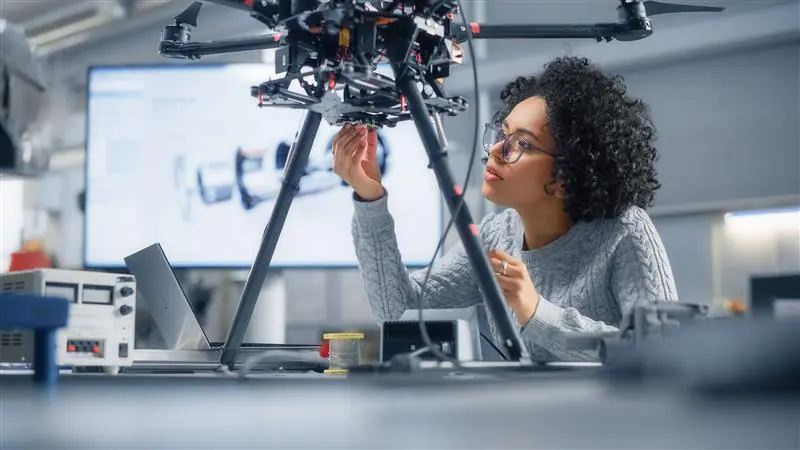Author: Senior Market Research Analyst, Infiniti Research
Unmanned Aerial Vehicles (UAVs), commonly known as drones, are not just a passing trend; they represent the forefront of technological innovation across various sectors. As we look ahead, the UAVs of the future promise to reshape industries, improve operational efficiencies, and even transform urban landscapes. In this post, we’ll explore emerging technologies, cutting-edge trends, and actionable insights for leveraging UAVs of the future.
Advanced Autonomous Capabilities: The Brain Behind the Drone
One of the most significant advancements in the future of UAV technology is the integration of artificial intelligence (AI) and machine learning. These technologies empower drones to perform complex tasks autonomously, allowing for:
Obstacle Detection and Avoidance:
Drones equipped with advanced sensors can navigate around obstacles without human intervention.
Automated Missions:
UAVs can be programmed to execute specific tasks such as surveying or inspections autonomously.
Swarm Technology:
Multiple drones can collaborate in coordinated swarms, enhancing efficiency for large-scale operations like environmental monitoring.
Imagine a fleet of drones working together to monitor a vast agricultural area. Each drone collects data on crop health and shares it with others in real time, creating a comprehensive overview that optimizes farming practices.
Enhanced Data Collection: The New Eyes in the Sky
The integration of sophisticated sensors is revolutionizing how UAVs gather and analyze data. Drones can now collect high-resolution imagery, thermal data, and even LiDAR scans. This capability has profound implications across various sectors:
Drones equipped with multispectral sensors can monitor crop health, detect diseases early, and optimize irrigation practices.
UAVs provide accurate topographical maps and monitor construction progress, ensuring projects stay on schedule.
High-precision data from drones helps track wildlife populations and assess forest health.
For instance, in disaster response scenarios, drones can quickly assess damage areas using thermal imaging to locate survivors or hotspots in real time.
Read more: Pharma Market Intelligence: Navigating Trends and Insights
Connectivity Revolution: 5G and Beyond
The arrival of 5G technology is set to revolutionize UAV operations. With enhanced connectivity comes:
- Real-Time Data Transmission: Drones can send and receive data at unprecedented speeds, enabling more sophisticated applications such as remote piloting over long distances.
- Improved Communication: Enhanced connectivity allows for better coordination between multiple drones in a swarm.
Consider emergency services utilizing drones to deliver medical supplies. With 5G, these drones can adapt their routes based on real-time traffic conditions or weather changes, ensuring timely deliveries even in unpredictable scenarios.
Explore how FemTech is revolutionizing women’s healthcare—To uncover actionable insights and investment opportunities in this transformative sector...
Urban Air Mobility: The Future Takes Flight
Urban Air Mobility (UAM) is an exciting concept that envisions a network of air transportation systems within cities. UAVs are central to this vision:
Imagine a future where you can summon an air taxi just like you would a rideshare vehicle—getting you from point A to B while avoiding traffic jams below!
Environmental Sustainability: Green Drones
As global awareness of environmental issues grows, so does the push for eco-friendly drone technology. Innovations include:
- Solar-Powered Drones: These drones harness solar energy during flights, extending their operational range.
- Hybrid Systems: Combining electric propulsion with traditional fuel sources allows for longer flights and heavier payloads without compromising efficiency.
This shift not only reduces carbon footprints but also opens up new possibilities for applications like wildlife monitoring and conservation efforts.
Actionable Tips for Engaging with UAV Technology

As we embrace this exciting future of UAVs, here are some actionable tips for individuals and businesses looking to get involved:
- Stay Informed: Follow industry news on UAV advancements to understand how they might impact your field.
- Invest in Training: If you’re in a sector that could benefit from drone technology (like agriculture or logistics), consider training programs that teach drone operation and data analysis.
- Explore Partnerships: Collaborate with tech companies specializing in drone technology to integrate UAVs into your operations effectively.
Conclusion: Ready for Takeoff
The future of UAVs is bright and full of potential. From advanced autonomous capabilities to sustainable practices, these innovations promise to transform how we work and live. As we stand on the brink of this aerial revolution, it’s essential to embrace these changes actively.
Whether you’re a business leader looking to enhance operational efficiency or an enthusiast eager to explore new technologies, the world of UAVs offers endless possibilities. So strap in—it’s going to be an exciting flight ahead!
Ready to harness the power of innovation in women’s health? Connect with our experts today to drive impactful change and unlock new growth potential.


